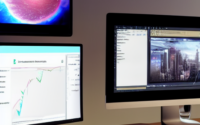The Influence of Tech on Urban Mobility
The Influence of Tech on Urban Mobility
Introduction:
Urban mobility is a critical aspect of modern city life, and technology has had a profound impact on the way we move around in urban environments. From the development of ride-sharing apps to the introduction of electric scooters, technological advancements have transformed the way we navigate cities. In this article, we will explore the various ways in which technology has influenced urban mobility and its potential implications for the future.
1. Transportation Network Companies:
Transportation Network Companies (TNCs) like Uber and Lyft have revolutionized the way people commute in urban areas. These ride-sharing services allow users to conveniently book a ride through a smartphone app, eliminating the need for traditional taxis or waiting for public transportation. TNCs provide a convenient, cost-effective, and efficient mode of transportation, reducing the reliance on private vehicles and decreasing traffic congestion in cities.
2. Electric Mobility:
The rise of electric mobility has had a significant impact on urban transportation. Electric vehicles (EVs) have gained popularity due to their environmental benefits and advancements in battery technology. With the growing availability of EV charging infrastructure, more people are opting for electric cars, reducing greenhouse gas emissions and air pollution in cities. Additionally, the introduction of electric scooters and bicycles has provided alternative options for short-distance travel, further enhancing urban mobility.
3. Smart Traffic Management:
Technology has enabled the implementation of smart traffic management systems in cities. Intelligent transportation systems use real-time data, such as traffic flow and congestion information, to optimize traffic signals and improve overall traffic efficiency. These systems help reduce travel times, minimize congestion, and enhance the overall urban mobility experience. Furthermore, advancements in vehicle-to-vehicle (V2V) and vehicle-to-infrastructure (V2I) communication systems allow for improved safety features and traffic coordination.
4. Mobility-as-a-Service:
Mobility-as-a-Service (MaaS) is an emerging concept that integrates various transportation modes into a single platform, improving accessibility and convenience for urban dwellers. MaaS platforms provide users with real-time information about public transportation, ride-sharing options, bike-sharing services, and more. By offering a comprehensive range of transportation choices, MaaS encourages a shift towards sustainable and efficient urban mobility, reducing the reliance on private car ownership.
5. Autonomous Vehicles:
The development and deployment of autonomous vehicles have the potential to revolutionize urban mobility. Self-driving cars have the capacity to increase road safety, optimize traffic flow, and reduce congestion. Additionally, autonomous vehicles can be shared, eliminating the need for parking spaces and reducing the overall number of vehicles on the road. However, the widespread adoption of autonomous vehicles raises various concerns, such as ethical considerations, cybersecurity, and the impact on jobs.
6. Data-Driven Decision Making:
The abundance of data generated by urban mobility systems is invaluable for city planners and policymakers. By analyzing real-time data on traffic patterns, transportation usage, and user behavior, cities can make informed decisions to improve infrastructure, optimize public transportation routes, and address specific mobility challenges. Data-driven decision making has the potential to enhance the efficiency and sustainability of urban transportation systems.
Conclusion:
Technology has undeniably transformed urban mobility, offering innovative solutions to tackle transportation challenges. From ride-sharing services and electric mobility to smart traffic management and autonomous vehicles, the influence of tech on urban mobility is profound. As technology continues to advance, it is crucial for cities to embrace these developments and integrate them into their infrastructure and policies to create more sustainable and accessible urban environments.

